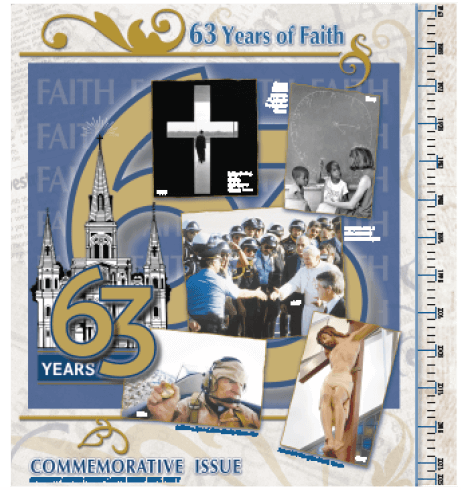Editor Peter Finney looks back on the ground-breaking start and the hand-delivered papers

NEW ORLEANS — No one in my family knows exactly what year the initials “PPF” were hand-scrawled on the musty plaster walls of St. Louis Cathedral’s far right steeple — about 120 feet above Jackson Square — but please understand that Peter Paul Finney Sr., a cathedral altar boy in the mid-1930s, was equal parts playful, inquisitive and mischievous.
If altar boy graffiti is a rite of passage that merits a few extra days in purgatory, then my father’s appointment to present his Catholic bonafides to Sts. Peter and Paul in 2016 was definitely delayed for further scrutiny, along with hundreds of other cathedral servers with equally bad penmanship.
Just above the “PPF,” after all, is none other than “J. Finney,” which belonged to my dad’s older brother John, who probably egged him on.
My father grew up on Chartres Street just a block from the cathedral. I mention this because for the last 32 years, whenever I had to cover a cathedral Mass for the Clarion Herald, I parked in the same interior courtyard where my dad played basketball, baseball, football, handball, and tennis, with the stucco walls providing both boundaries and backboards.
My final assignment for the Clarion Herald — June 14 — fittingly came at the cathedral. Archbishop Gregory Aymond ordained seven men to the permanent diaconate. It was a touchstone for my 32 years as a Catholic journalist, where weekends are big business and transform people’s lives.
Actually, our job at the Clarion Herald for the last 63 years was to plant small seeds that somehow, through God’s mysterious providence, triggered a metanoia in someone carrying an unseen yoke of pain or confusion. It was humbling when we received a nudge that someone read a small item buried on an inside page — in the middle of much larger stories — and experienced a new life.

I’ve always said, if you accept the notion bandied about by some priests that people don’t read the Clarion Herald (or any other Catholic publication), just make a mistake and see how many emails start flying in.
After Hurricane Katrina, our staff personally dropped off the Clarion Herald to churches in Baton Rouge, Lafayette, Houma and Thibodaux — where the New Orleans diaspora had found spiritual and pastoral welcome in exile. People literally grabbed the papers out of our hands. They needed to know the latest information — anything — about how their priest and their parish was doing.
I remember telling Ron Kogos, one of our ad reps, as we slogged, sweat-soaked, to our cars with bundles of papers on a 95-degree October afternoon: “Ron, I’d hate to be doing this for a living.” Instantly, I caught myself. “Wait a minute — we are doing this for a living!”
The emotional response our staff received delivering the Clarion Herald was more authentic and accurate than any focus group or a statistically valid survey: What we do in Catholic media matters. We transform people’s lives. It took a tragedy to teach us that firsthand, but it is true everywhere a Catholic editor fills a hole on page 17 with a story that silently becomes a resurrection parable to a reader searching for a lifeline.
As the Clarion Herald ended 63 years of newspaper publication June 28 with a 64-page commemorative issue (the e-edition is available here). I am eternally grateful not only to my current staff but also to those who came before me.
It was November 1962, and Frank H. Methe, a staff photographer for The Times-Picayune in New Orleans, got a call from Emile Comar, his former colleague at The States-Item, about a job opening.
Comar had been hired away from The States-Item, the city’s afternoon daily, a few weeks earlier by Archbishop John P. Cody and Father Elmo Romagosa with the promise of a $1,000-a-month salary — a princely sum for someone with five kids in Catholic schools.
“Having five young children at home made that an easy choice,” Comar said in a 2013 interview. “I entered the Catholic press not by any particular calling but because Archbishop Cody offered a salary well above what I was making as a political writer and columnist. That being said, I never regretted the change.”
Comar’s mission from Archbishop Cody was simple. With the Second Vatican Council throwing open the doors of the universal church and with the civil rights movement reshaping the Deep South, Archbishop Cody wanted to establish the best Catholic diocesan newspaper in the country. Quickly.
To do that, Comar knew he needed to hire talented people. Little did Methe know when he first talked to Comar about the new venture that the Clarion Herald — the successor of the Catholic Action of the South — would revolutionize the Catholic press in the United States when it produced its premier issue Feb. 28, 1963.
“The archbishop opened the purse strings to my immediate boss, Father Romagosa,” Comar recalled. “His directive was that he wanted the best Catholic paper in the country.” To back that up, Archbishop Cody promulgated that the Clarion Herald would be mailed to every Catholic home 50 weeks a year, with an initial press run of 130,000. We did the math: Since 1963, the Clarion Herald produced 200 million copies.
It wasn’t simply that the Clarion Herald would be printed on a technologically advanced offset press capable of reproducing photographs with a clarity unmatched by either of the city’s two dailies. It was that the Clarion Herald would become both a Catholic and a community newspaper — tackling the religious and political issues of the day but also remembering who its readers were.
The Clarion Herald wasn’t just writing and shooting pictures for the choir.
Methe, who turned 95 in August, recalled wondering if he wanted to leave his comfortable secular newspaper existence — chasing car accidents, murders and the wild ramblings of Gov. Earl Long — to take “church” pictures.
“The thing in my mind was I didn’t want to shoot religious pictures for the rest of my life,” Methe said of his first meeting with Comar. “Emile said, ‘No, we’re going to spread it around. It’s a Catholic newspaper, but it’s not going to be just religion.’ And it wasn’t.”
A glance at the Clarion Herald archives (all 63 years of the Clarion Herald are digitally available at thecatholicnewsarchive.com) confirms that eclectic approach. Mixed in with reports on Vatican II and the gathering storm of legalized abortion are feature stories and photo spreads on the offshore oil industry, sulphur mining, sugar cane harvests, urban poverty, Cajun culture, and the pre-dawn backstretch at the Fair Grounds.
“The idea was, it may not be a ‘religious’ story, but you’ve got Catholics involved in it and Catholics are working for these people,” Methe said. “The rest of the paper was religious.”
Florence Herman, who started with the Clarion Herald in 1966, retired as managing editor and passed away in 2015, said in a 2013 interview that the Fair Grounds photo story was typical of the newspaper’s thinking that its stories and features didn’t have to be black-and-white (as in, clerical attire) to be read all over.
“We had no limits,” Herman said. “The operative thing Emile always would say was, ‘If it’s of interest to us, it’s of interest to our readers, because we are our readers.’ We got more compliments and comments on that Fair Grounds page because everybody played the horses in this town and they loved the track.”
Methe said the photo reproduction of the Clarion Herald was so superior to anything in its day that it changed the photographic process. The Century Graphics press could handle a 100-line screen — meaning the dot pattern in the photographs was very small in comparison to the larger dot pattern used by the Picayune. Think 4K television versus Etch-a-Sketch.
“It was all the difference in the world, and people were amazed at the quality — especially me,” Methe said. “When I was at the Picayune, all the photographs had to be retouched. They would spray out the background so the people would stand out. They had to use a white outline to help people stand out. But you didn’t have to touch these pictures. It just blew my mind. It blew a lot of people’s minds.”
And now … By name, the Clarion Herald will continue as a biweekly bulletin/newsletter produced by the archdiocesan communications office with a modest staff. God bless them.
We thank our readers for cherishing our stories.
For my part, I am happy to share my father’s initials: PPF.
Finney, an award-winning editor and journalist, received the St. Francis de Sales Award in 2013. This article first appeared in the September 2025 edition of The Catholic Journalist.
